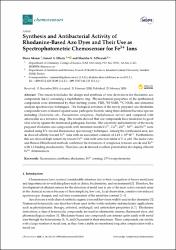Synthesis and Antibacterial Activity of Rhodanine-Based Azo Dyes and Their Use as Spectrophotometric Chemosensor for Fe3+ Ions
Özet
This research includes the design and synthesis of new derivatives for rhodanine azo
compounds (4a–c) containing a naphthalene ring. Physiochemical properties of the synthesized
compounds were determined by their melting points, FTIR, 1H-NMR, 13C-NMR, and elemental
analysis spectroscopic techniques. The biological activities of the newly prepared azo rhodanine
compounds were evaluated against some pathogenic bacteria using three different bacterial species
including (Escherichia coli., Pseudomonas aeruginosa, Staphylococcus aureus) and compared with
amoxicillin as a reference drug. The results showed that our compounds have moderate-to-good
vital activity against the mentioned pathogenic bacteria. The selectivity and sensitivity of the newly
prepared rhodanine azo compounds with transition metals Co2+, Cu2+, Zn2+, Ni2+, and Fe3+ were
studied using UV–vis and fluorescence spectroscopy techniques. Among the synthesized azos, azo
4c showed affinity toward Fe3+ ions with an association constant of 4.63 × 108 M−1
. Furthermore,
this azo showed high sensitivity toward Fe3+ ions with detection limits of 5.14 µM. The molar ratio
and Benesi–Hildebrand methods confirmed the formation of complexes between azo 4c and Fe3+
with 1:2 binding stoichiometry. Therefore, azo 4c showed excellent potential for developing efficient
Fe3+ chemosensors.
Cilt
8Sayı
1Bağlantı
https://hdl.handle.net/11363/5390Koleksiyonlar
Aşağıdaki lisans dosyası bu öğe ile ilişkilidir:


















